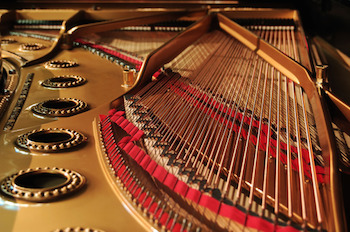Just like people, pianos have unique voices.
The grand piano in the lobby of a five-star hotel sounds a lot different than the piano that lived in the living room of your parents’ home. But what makes pianos sound different from one another?
A piano’s voice differs from whether it’s in tune. Tuning a piano involves adjusting the strings’ tension.
A piano’s unique voice comes from the sound that the hammers make when they hit the piano’s strings. The felt covering on these hammers can vary in hardness, density, surface area, and quality. All of these factors affect the sound of each note played, giving your piano its unique voice.
A piano’s tone can be shifted with a process called “piano voicing.” Experienced piano technicians usually do this in order to even out the tones of individual notes. Voicing the whole piano to make it have a different voice is possible, but it takes an experienced professional to do it well, and it takes a long time.
Want to describe your piano’s voice? Here are some words to do so.
Warm, Mellow
Warm-sounding pianos are well-balanced and appealing. Many technicians try to voice pianos to sound warm, as it works for most types of music. A warm sound is also generally appealing to listeners.
Bright, Shrill
Bright voiced pianos have a higher sound, creating music that is lively, clear, and pleasant. This higher sound may sound shrill to some ears.
Dark
Pianos that are bass-heavy have a dark voice with a booming, rich sound. Too much bass can make a piano sound unbalanced, and this can sometimes be a sign of cheaply-made hammers.
Rich
Rich-sounding pianos have a lot of auditory interest. They have enhanced bass and treble tones, while still feeling balanced. A rich-sounding piano is more interesting to listen to, as it provides more complex tones.
Big, Powerful
Pianos with a “big” sound are usually found in concert halls and stages, where they can be heard and enjoyed by many. Pianos with a big voice have a lot of power and can easily fill a room.
Clear and Even
Clarity of piano sound generally comes from a well-made piano that’s been finely tuned. It’s hard to sustain perfect clarity and evenness in a piano, especially over time. New pianos are naturally more even, as the felt on the hammers has not been worn down yet.
So which sound is best?
A concert pianist may prefer a piano with a big, rich sound, while you might prefer the relaxing sound of a warm, mellow piano in your own home. While some pianos sound generally appealing to people, such as ones with a warm or rich sound, there is ultimately not a definitive “best sounding” piano out there. It’s all down to personal preference: beauty is in the ear of the listener!



